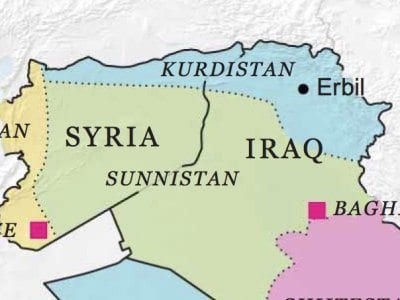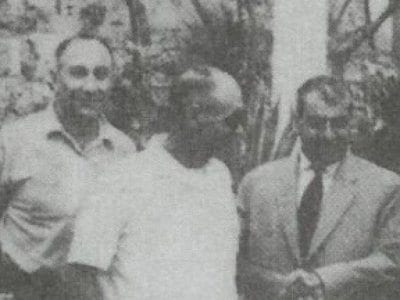An accidental tour into the heart of the caliphate’s oil smuggling economy.
- By Marwan Hisham
I met Abu Samou when he pulled over to the side of the road in his small Foton truck in Al-Bab, a lifeless city with mostly empty streets northeast of Aleppo controlled by the so-called Islamic State. I was heading for the Turkish border with the aim of settling in Turkey, but since the Islamic State bans everyone except traders from leaving its caliphate, I only had two options. I could try walking out of Islamic State territory via smuggling routes that pass through mine fields, or I could try to find a truck driver kind enough to help me. Hitchhiking seemed like the better bet.
I knew hitchhiking would involve crossing the dangerous front line between the “caliphate” and rebel-held territory. What I didn’t realize is that the journey would also include a harrowing, first-hand education in the workings of the contemporary Syrian economy.
I was advised to approach the men who drive oil across northern Syria, in the hope of finding someone who would be OK with my posing as an “assistant” at Islamic State checkpoints. So I set myself up at the Aleppo-bound side of the Hazwan traffic junction on the outskirts of Al-Bab, and after hiding my bag behind a rock, I waited.
![]() “I’ll signal 20 trucks before I give up,” I told myself.
“I’ll signal 20 trucks before I give up,” I told myself.
Twenty trucks passed by in an hour or so. None stopped for me. But I couldn’t bear the thought of returning home, so I resolved to test my luck a little while longer.
After three hours of waiting helplessly, Abu Samou pulled over. A middle-aged man with a red keffiyeh wrapped around his head and fingers stained with mazut, Abu Samou’s wide, cheerful face made him seem trustworthy and kind. He quickly agreed to take me to his hometown of Marea, a rebel-controlled area that is nonetheless surrounded by the Islamic State on three sides. From there, I could easily reach the border, which is only a short drive away.
After hopping into his truck, I learned Abu Samou is one of hundreds of oil traders who cross the muddy fields that link Islamic State territories to the rebel-held ones. He buys his diesel oil in Al-Bab, the town in the eastern countryside of Aleppo province, and sells it in Marea or Azaz.
Al-Bab is the Islamic State’s gateway to the outside world: Here, oil produced in Islamic State-controlled fields is transported to rebel-held towns, while goods, which come across the Turkish border, travel in the other direction, providing a lifeline for the population residing under the militant group’s rule.
Even while war rages between the many factions struggling for control in Syria, economic life continues between the country’s fractured territories. The Islamic State uses the sale of oil to finance its wars, while for the civilians and anti-Assad armed groups that inhabit the region, buying Islamic State-produced oil is the only way that they can get their hands on enough fuel to make their cities habitable.
Men like Abu Samou — who is not a member of the Islamic State, but a civilian trying to earn a living — are the middlemen who make this possible.
Men like Abu Samou — who is not a member of the Islamic State, but a civilian trying to earn a living — are the middlemen who make this possible.While Turkey is widely blamed for buying Islamic State oil, most of the group’s output is actually consumed locally in Syria. As the Financial Times detailed in an investigation most recently updated in February, the group charges between $25 and $45 per barrel of oil, selling the fuel to independent traders who then transport it to rebel- and Kurdish-held territory in Syria. Oil sales are a major source of revenue for the group: The Islamic State produced up to 40,000 barrels a day from its fields in the eastern province of Deir Ezzor in October, according to the same investigation.
It’s not hard to set yourself up as an oil dealer in northern Syria. You can start your own business with no more than $5,000 — the cost of a Chinese-made truck and supplies. Abu Samou had even less when he began: He started with a little more than $2,000, and in a few months, he was able to pay off the cost of his truck in installments. Right now, he carries 10 oil barrels at a time, earning $100 for each trip — equal to a month’s salary for an average worker in the region.
But Abu Samou risks his life every time he makes the trek. Russian warplanes have started bombing the trucks selling goods in this area — a fact made clear by the charred vehicles lying by the side of the road during our journey. “It’s now more lucrative because of what you see here,” he said.
Before the Russian campaign, Abu Samou made $25 a trip. This is the inflation of risking one’s life.
“Every journey I make since the Russians started to bomb the crossroads, targeting specifically oil trucks, I say to myself, ‘That’s enough,’” he told me. “But I need to save money so I can start another business.”
Even if Abu Samou is lucky enough not to end up like the other charred wrecks along the highway, he must navigate the perilous roads. In the absence of a government to maintain them, these vital roads remain hollowed out by bombs and shells in some parts and by asphalt erosion in others, which become inaccessible when it rains. But the worst is the closure of the road at the front line. For a few miles, trucks draw their way through agricultural fields. Abu Samou uses his keen driving skills to follow the solid track carved out by tires on unsound terrain so he avoids getting stuck in the mud, or else he will end up paying half of his pay on a tractor to pull him out.
The Russian Air Force claims to be targeting oil sales when it bombs this trade route, but civilian traders carrying basic goods are getting caught in the crossfire. Footage released by the Russian Defense Ministry in December 2015 shows vehicles burning in the aftermath of airstrikes. The caption says that these trucks “carry oil,” but I could clearly see, in my travels, that the hit trucks are laden with goods of all kinds.
While Abu Samou concentrated on driving and the treacherous passage, my eyes widened at the destruction.
While Abu Samou concentrated on driving and the treacherous passage, my eyes widened at the destruction. One truck was loaded with chicken cages, with some live chickens and some dead, clearly generous meals for starving dogs to feast on. One truck carried scorched oranges that were strewn along the road, which were nevertheless still picked up and eaten by passersby. Another, blocking the road, carried hundreds of Turkish steel bars for construction.Trade not only links Islamic State- and rebel-controlled areas, but it also extends to Afrin, the Kurdish canton that is controlled and run by the U.S.-backed Syrian Democratic Forces (SDF). And when the battle lines in this war shift, economic agreements have to be renegotiated as well.
On Jan. 3, the Syrian army — backed by foreign Shiite militias and supported from the air by Russian fighter jets — broke the rebels’ siege on the Shiite villages of Nubul and Zahraa. This meant that the only oil supply route to rebel-held areas in Aleppo from the northern countryside was cut off. This line had been supplying the rebels’ territory with diesel and gasoline, as well as crude, for years. The rebels soon found themselves at the mercy of their enemy, the SDF, to allow oil trucks to supply the northern provinces of Aleppo and Idlib.
Mustafa, the pseudonym of an Ahrar al-Sham fighter, later told me that his group, along with the other rebels, had “reached a temporary alternative solution,” in which oil trucks were allowed to transport oil so the fuel could reach these rebel-held territories.
“They [the SDF] are taxing oil transporters a lot of money,” Mustafa said. “They struck a deal, and they are benefitting from that.”
According to Aleppo Media Center activist Mohammad Basbous, the SDF taxes oil trucks 2,000 Syrian pounds — or roughly $4 — per barrel. While eager to turn a profit, the forces in Afrin also need the oil to keep coming: The Kurdish canton “depends entirely on the oil coming from Azaz and, before that, from Islamic State oil fields,” an SDF-affiliated reporter told me.
When it suits them, however, each side uses the oil trade as a weapon of war. Every time fighting between the SDF and rebels erupts, roads get cut off, and thus their territories suffer shortages of oil, which drive up fuel prices. “The area is hostage to different ideological agendas and different backers’ strategies,” Mustafa said. And for that, civilians pay the price.
Last June, while I was in Aleppo, the fighting between rebel forces and the Islamic State stopped the oil trade between their territories. The blockade lasted for nearly a month, and it cost the rebels and people living under them dearly. Gasoline prices jumped to $4 a liter, and diesel vanished from the markets; as a result, most cars stopped moving.
The Islamic State’s leaders were well-aware that their enemies’ dependence on oil grants them an important weapon. As the fighting continued, the Islamic State emir of Al-Bab threatened his enemies on the other side of the front: “I swear by God we’ll make you trail your tanks and vehicles by donkeys.” But as long as the Islamic State is itself dependent on oil revenues, that threat will never be very credible.
In Marea, Abu Samou refused to take the money I offered him for the ride. “I do this to help people who need to leave Islamic State-held territory,” he insisted. “I never do it for money.” Left unspoken was that he didn’t include himself among such people. In two or three days, as I continued my journey, Abu Samou was going to make the return trip back into Islamic State territory. He would have an empty truck and a full wallet.
Image credit: JOHN MOORE/Getty Images






